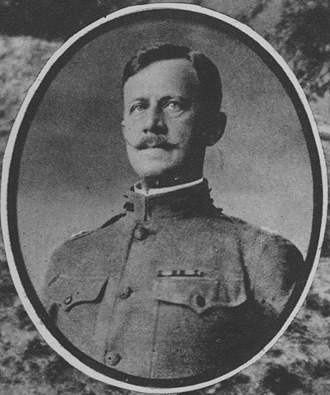When Robert Jayne Maxey was born on May 8, 1873, in Rankin, Mississippi, his father was 32 and his mother, Marie, was 21. He married Lucretia "Lu" Knowles on November 29, 1904, in Missoula, Montana. They had two children during their marriage. He served in the U.S. Army during World War I as a Lieutenant Colonel in the 28th Infantry Regiment, 1st Infantry Division.
From:
Forty-Ninth Annual Report Of The Association of the Graduates Of The United States Military Academy At West Point, New York
June 11th, 1918.
Robert Jayne Maxey
No. 3862. Class of 1898.
Died May 28, 1918, near Cantigny, France, aged 45.
Lieutenant Colonel Maxey was born in Mississippi on May 8, 1873, entered the United States Military Academy in June 1894 and was graduated April 2, 1898. He was assigned to the 6th Infantry and served with that regiment in the Santiago Campaign. In 1899 he was ordered to the Philippines where he served three years in the Southern Islands. He returned to the States in 1902 and was stationed at Fort Leavenworth where he was an instructor in the Service School. In 1903, he became a Captain and was ordered to Missoula, Montana, where, on November 29, 1904, he married Miss Lu Knowles, daughter of Judge Hiram Knowles of the United States Federal Court. He served three tours of duty in the; Philippines, returning from the last in 1913. In 1915, he was detailed to the Army School of the Line and graduated an honor man. In 1916 he attended the Staff Class at Leavenworth and was graduated early on account of the Mexican trouble.
Early in 1917, at the request of General Martin, he was detailed to attend the officers' training camp at Leon Springs, Texas. In May 1917, he rejoined his regiment and accompanied it to France, going over with the first Expeditionary Force, in June 1917. He was instructor in small arms firing to April 1918, joined the Twenty-eighth Infantry about May 14, 1918 and a few days later, at the Battle of Cantigny, received wounds of which he died May 28th. He was cited for having advanced with his first wave in the face of heavy shell and machine-gun fire. The citation adds:
He was cool under fire and a dependable leader. Although fatally wounded, he gave detailed directions to his second in command as to just what to do and caused himself to be carried to the post of command of his regiment to give information to his regimental commander that he considered very important before being evacuated. This was under intense shell and machine-gun fire.
Captain C.R. Hueber, Twenty-eighth Infantry, the second in command of the Battalion during the attack, gives the following account:
Lieutenant Colonel R.J. Maxey commanded the Second Battalion of the Twenty-eighth Infantry, in the attack upon Cantigny. In the early part of the engagement he was advancing with the first line of the Infantry when he was wounded in the neck by a shell fragment which later caused his death. He was placed upon a litter and was being carried to the first aid station when he insisted upon being taken to my position as he said he had some orders that he wanted to turn over to me. Upon reaching the position of my company, he ordered the litter bearers to lay him down and go and get me. I was about 200 yards away, superintending the construction of a strong point. When I reached the Colonel I found him upon the litter and helpless, but he could speak and gave me full and complete instructions as to how to carry on. He had me get his map and showed me on the map where the positions were to be and how to defend them. All this time we were under heavy machine gunfire with an occasional artillery shot. He showed utter disregard for his own wound and thought of nothing but the success of the operation nor would he proceed on his way until he was sure that I understood everything, thereby inspiring great devotion and courage.
He was a brave soldier, a worthy friend and a devoted son and husband. He leaves a widow, two sons, Curtis Knowles Maxey and Radcliffe Stevens Maxey, a mother [Mrs. Marie Stevens Alford] and three sisters [Mrs. Mildred Marie Alford Bowen, wife of Lieut. Colonel Frank Sayles Bowen; Mrs. Marguerite Alford Mitchell, wife of Major C.L. Mitchell and Mrs. Ida Goodloe Alford Halford, wife of Major Dean Halford.

PRIVATE CITIZENS SUPPORTING AMERICA'S HERITAGE
American
War Memorials Overseas, Inc.
War Memorials Overseas, Inc.
Maxey Robert Jayne
Name:
Robert Jayne Maxey
Rank:
Lieutenant Colonel
Serial Number:
Unit:
28th Infantry Regiment, 1st Infantry Division
Date of Death:
1918-05-28
State:
Mississippi
Cemetery:
United States Military Academy Post Cem., NY
Plot:
Section VIII, Site 35
Row:
Grave:
Decoration:
Comments:
